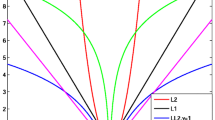Abstract
We propose three novel methods for recovering edges in piecewise smooth functions from their possibly incomplete and noisy spectral information. The proposed methods utilize three different approaches: #1. The randomly-based sparse Inverse Fast Fourier Transform (sIFT); #2. The Total Variation-based (TV) compressed sensing; and #3. The modified zero crossing. The different approaches share a common feature: edges are identified through separation of scales. To this end, we advocate here the use of concentration kernels (Tadmor, Acta Numer. 16:305–378, 2007), to convert the global spectral data into an approximate jump function which is localized in the immediate neighborhoods of the edges. Building on these concentration kernels, we show that the sIFT method, the TV-based compressed sensing and the zero crossing yield effective edge detectors, where finitely many jump discontinuities are accurately recovered. One- and two-dimensional numerical results are presented.
Similar content being viewed by others
References
Alvarez, L., Morel, J.-M.: Formulation and computational aspects of image analysis. Acta. Numer. 3, 1–59 (1994)
Candes, E., Romberg, J., Tao, T.: Robust uncertainty principles: exact signal reconstruction from highly incomplete frequency information. IEEE Trans. Inf. Theory 52, 489–509 (2004)
Candes, E., Romberg, J., Tao, T.: Stable signal recovery from incomplete and inaccurate measurements. Commun. Pure Appl. Math. 59, 1207–1223 (2005)
Romberg, J., Candes, E.: l1 magic software, http://www.acm.caltech.edu/l1magic/
Canny, J.: A computational approach to edge detection. IEEE Trans. Pattern Anal. Mach. Intell. 8, 679–714 (1986)
Clark, J.J.: Authenticating edges produced by zero-crossing algorithms. IEEE Trans. Pattern Anal. Mach. Intell. 2(1), 43–57 (1989)
Donoho, D., Elad, M., Temlyakov, V.: Stable recovery of sparse overcomplete representations in the presence of noise. IEEE Trans. Inf. Theory 52, 6–18 (2006)
Donoho, D., Tanner, J.: Sparse nonnegative solutions of underdetermined linear equations by linear programming. Proc. Natl. Acad. Sci. 102(27), 9446–9451 (2005)
Engelberg, S., Tadmor, E.: Recovery of edges from spectral data with noise—a new perspective. SIAM J. Numer. Anal. 46(5), 2620–2635 (2008)
Fleck, M.M.: Some defects in finite-difference edge finders. IEEE Trans. Pattern Anal. Mach. Intell. 14(3), 337–345 (1992)
Gelb, A., Tadmor, E.: Detection of edges in spectral data. Appl. Comput. Harmon. Anal. 7, 101–135 (1999)
Gelb, A., Tadmor, E.: Detection of edges in spectral data II. Nonlinear enhancement. SIAM J. Numer. Anal. 38, 1389–1408 (2001)
Gelb, A., Tadmor, E.: Spectral reconstruction of piecewise smooth functions from their discrete data. Math. Model. Numer. Anal. 36(2), 155–175 (2002)
Gelb, A., Tadmor, E.: Adaptive edge detectors for piecewise smooth data based on the minmod limiter. J. Sci. Comput. 23(2–3), 279–306 (2006)
Marr, D., Hildreth, E.: Theory of edge detection. Proc. R. Soc. Lond. B 207, 187–217 (1980)
Rudelson, M., Vershynin, R.: Geometric approach to error correcting codes and reconstruction of signals. Int. Math. Res. Not. 64, 4019–4041 (2005)
Tadmor, E.: Filters, mollifiers and the computation of the Gibbs phenomenon. Acta Numer. 16, 305–378 (2007)
Ulupinar, F., Medioni, G.: Refining edges detected by a LoG operator. Comput. Vis. Graph. Image Process. 51(3), 275–298 (1990)
Zou, J., Gilbert, A., Strauss, M., Daubechies, I.: Theoretical and experimental analysis of a randomized algorithm for sparse Fourier transform analysis. J. Comput. Phys. 211, 572–595 (2006)
Zou, J.: A sublinear algorithm for the recovery of signals with sparse Fourier Transform when many samples are missing. Appl. Comput. Harmon. Anal. 22, 61–77 (2007)
Zou, J.: Sublinear Algorithms for the Fourier transform of signals with very few Fourier modes: theory, implementations and applications. Ph.D. Dissertation, Princeton University, 2005
Author information
Authors and Affiliations
Corresponding author
Additional information
Communicated by Ronald A. DeVore.
Research was supported in part by NSF grants DMS04-07704, DMS07-07949 and ONR grant N00014-91-J-1076.
Rights and permissions
About this article
Cite this article
Tadmor, E., Zou, J. Three Novel Edge Detection Methods for Incomplete and Noisy Spectral Data. J Fourier Anal Appl 14, 744–763 (2008). https://doi.org/10.1007/s00041-008-9038-9
Received:
Revised:
Published:
Issue Date:
DOI: https://doi.org/10.1007/s00041-008-9038-9
Keywords
- Edge detection
- Concentration factors
- The RAℓSFA algorithm
- Compressed sensing
- Zero crossing
- Incomplete data




